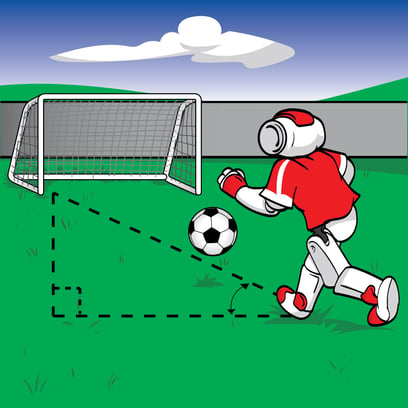Research shows that teachers can integrate technology to help students grasp mathematical procedures and develop advanced mathematical proficiencies. The National Council of Teachers of Mathematics (NCTM) added that technological tools are necessary for engaging students. What types of technology can be implemented into mathematics classrooms? The following section offers several ideas that can help when teaching math to kids.

Here are some effective tools for teaching math with technology.
1. VmathLive
VmathLive features online mathematics competitions for students in grades K-8. This is a paid product.
The offering features four primary components:
-
An “Intelligent Teacher Dashboard” area that tracks student performance, including activity metrics, class progress for goals and milestones, and alerts for students who are struggling.
-
A “Learn” component allowing students to progress at their own pace, through questions from 334 math topics.
-
A “Master” component that quizzes students on what they have learned.
-
A “Play” component with real-time competitions from students across the United States.
VmathLive costs $10 per student or $200 per class (up to 25 students), according to the company’s product page at the time of publication.
2. Desmos
Desmos offers a free web-based graphing calculator as well as digital activities for grades 6-12.
The primary offering is a calculator that matches the functionality of many $100-plus TI calculators. It’s a popular option for those who are looking to effectively teach math with technology. The other offering from Desmos, the digital activity center, presents several interactive lessons that students can perform on their own tablet or device. There is a section that enables teachers to create and share lessons with other teachers.
3. EquatIO
EquatIO is a tool for creating mathematical equations, formulas, Desmos graphs, and more on computers or Chromebooks.
The product seeks to digitize mathematics by simple input methods. Teachers can type, handwrite, or dictate expressions to add the result to a document, and there is a large library full of premade expressions. In other words, it’s sort of a smart assistant that can replace pen and paper, as well as offer prediction capabilities. The product works with literacy software Read&Write (paid), which is helpful for blending accessibility and teaching math with technology.
EquatIO is free for teachers. Paid licenses are available for other types of users and groups.
4. Kahoot!
Kahoot! is an interactive game that presents multiple choice questions to students in the same classroom. This learning tool offers free and paid plans.
Teachers can search for premade questions and answers in a variety of subjects, or they can create their own (paid). Questions are projected on a screen in the classroom, and students select the answer on their devices. The highest scoring students are displayed before the next question, creating a fun, competitive atmosphere.
Kahoot! has a basic free plan, as well as two paid plans ($1 or $3 per teacher/month) that offer more advanced features.
5. Online Games
Teaching math to kids with online games is a popular method of engagement. Here are two free websites that feature a wide variety of interactive games for students in grades 1-6:
-
Arcademics.com is an award-winning educational website that offers free multiplayer games, arcade math games, and more. The games adhere to Common Core math standards and span topics such as shapes, math functions, integers, fractions, and algebra.
-
Math Playground offers several math and logic games, as well as arcade-based activities and math videos. A small number of games require a paid subscription.
6. SMART Board Activities/Games
Classrooms equipped with SMART boards can take advantage of free activities and games available across the internet.
Sites such as SMART Exchange and iSmartboard.com help teachers find thousands of fun lessons, and they are organized by grade level. Many of the activities and games are submitted by teachers who are already using them for teaching math to kids in the classroom.
7. Sumdog
Sumdog is an adaptive learning tool for teaching math with technology to students in grades K-8. Paid subscription plans unlock premium teacher tools.
Sumdog features game-based learning that motivates and engages students. On computers and tablets, students answer questions at their own pace, with activities geared towards their skill level. Positive reinforcement rewards students’ achievements in the game, and teachers receive assessment data to guide lessons and examine individual student needs. Effectiveness studies and case studies have found improvements in student achievement with the product.
Pricing quotes are available through Sumdog’s website.
8. YouTube Videos
YouTube is a great source for interactive videos that help students learn mathematical concepts and practice what they’ve learned. Here are some of the most noteworthy YouTube channels for math instruction:
-
Khan Academy has a multitude of free videos covering basic and advanced concepts.
-
Mathademics offers short videos on elementary and middle school topics, focusing on subjects such as geometry and fractions.
-
Numberphile features colorful videos on topics such as Pi, prime numbers, and games like Yahtzee.
Teachers can also create their own YouTube videos, for a unique perspective on teaching math with technology. Examples range from a more elaborate and wacky show to a simpler and more focused clip in the real world.
Engaging Your Students in Mathematics
According to the NCTM, teachers must be knowledgeable in implementing technology to help teach mathematics. Using some of the aforementioned resources effectively requires a strategic approach.
You can strengthen that ability by earning an online master’s in mathematics education, which includes an elective course on technology in mathematics classrooms. In this degree program, you’ll deepen your understanding of mathematical concepts and their usage throughout the K-12 spectrum. You’ll develop the mathematics content and pedagogy needed to instill a deep interest for math in the next generation of learners.
Advance your career with a degree from Aurora University Online. Learn from practitioner-based faculty members focused on helping working professionals reach their goals. Experience what it means to study in a flexible and convenient learning environment, while receiving the personal attention and support you expect of a small college.
Discover teaching math with robots and RobotLAB!
Check all our math lessons on our learning platform Engage!K12 and teach with different robots and simulations! Engage your students in a fun and engaging way

